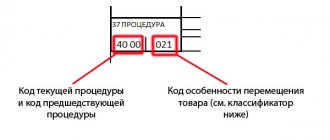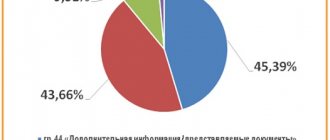Where is it used?
In practice, information defining the identity or homogeneity of a product, work, or service is used when:
- The initial (maximum) contract price (NMCP) is formed according to Art. 22 44-FZ and Order of the Ministry of Economic Development No. 567 of 10/02/2013.
- Calculate income in transactions for taxation under Art. 105.9 NK.
- The price of products is determined according to customs legislation as part of the implementation of the decision of the Board of the Eurasian Economic Commission No. 202 of October 30, 2012.
- They conduct an examination of applications for state registration of trademarks and service marks under civil law in the framework of the execution of Rospatent Order No. 128 of July 24, 2018.
When determining the NMCC, determine the cost of purchase based on prices for identical GWS. And if they are not there, use homogeneous ones.
Signs: product and service
A manufacturer, in order to individualize the products he produces, can register a trademark in the State Register, that is, his exclusive right to use a unique designation of a product (in everyday life you can find terms of similar meaning: “brand” and “trademark”). The concept of “service mark” is applied to the work performed or the provision of services. They can be:
- verbal or graphic (unique image);
- voluminous or have an original shape (of the product itself or its packaging);
- combine several elements (combined);
- a certain color or sound;
- tactile and others.
How to determine identity
In accordance with the methodological recommendations of the Ministry of Economic Development of the Russian Federation, goods that have the same basic characteristics characteristic of them are recognized as identical:
- functional;
- technical;
- quality;
- operational characteristics.
When determining the identity of goods, consider:
- country of origin;
- manufacturer.
If the goods differ slightly in appearance, these differences are not taken into account.
As for works and services, the main signs of identity for them are:
- use of the same methods, technologies, approaches;
- comparable qualifications of contractors.
Determination of identity and homogeneity of goods (works, services)*(24)
When collecting price information to establish the initial (maximum) price of a contract, the price of a contract concluded with a single supplier (contractor, performer), it is necessary, first of all, to focus on the prices of goods, works, services that the customer considers identical or, in their absence , homogeneous.
If previously the customer, based on the specific model of the purchased product, purchased service or work, looked on the market how much a similar or identical product, work, service costs, now the customer creates a list of requirements for the product, work, service and asks the market what fits these descriptions. Thus, it turns out that the purchasing philosophy has changed a lot, especially when it comes to purchasing goods.
An accurate description of the procurement object (the use of indicators and their values) and the use of such concepts as “identity” and “homogeneity” allow the customer to first determine with maximum accuracy the price range for the procurement object, and then calculate the initial (maximum) price of the contract, the price of the contract concluded with a single supplier (contractor, performer). First, Federal Law N 44-FZ, and later in the Methodological Recommendations, discloses the concept of “identical goods, works; goods, works, services that have the same basic characteristics characteristic of them are recognized. When determining the identity of goods, minor differences in the appearance of such goods may not be taken into account. When determining the identity of works and services, the characteristics of the contractor, performer, and their business reputation in the market are taken into account” * (22). Thus, identical goods, works, services are those goods, works, services that most closely correspond to the description and requirements of the customer in order to satisfy their needs. “Homogeneous goods are goods that, while not identical, have similar characteristics and consist of similar components, which allows them to perform the same functions and (or) be commercially interchangeable. When determining the homogeneity of goods, their quality, reputation in the market, and country of origin are taken into account. Homogeneous works and services are works and services that, while not identical, have similar characteristics, which allows them to be commercially and (or) functionally interchangeable. When determining the homogeneity of work and services, their quality, reputation in the market, as well as the type of work, services, their volume, uniqueness and commercial interchangeability are taken into account” * (23). This information can be presented more clearly in the form of a table (Table 1).
Table 1
| Group of goods (works, services) | Signs | Features of the definition |
| Identical goods (Part 13, Article 22 of Federal Law N 44-FZ, clause 3.5.1 of the Methodological Recommendations) | The same characteristic main features (functional, technical, quality, as well as operational characteristics) | When determining identity, the following may be taken into account: – country of origin; - manufacturer. Slight differences in the appearance of goods may not be taken into account. |
| Identical works, services (Part 13, Article 22 of Federal Law N 44-FZ, clause 3.5.2 of the Methodological Recommendations) | Identical basic quality characteristics, including those implemented using the same methods, technologies, approaches | The identity of the work (services) is determined taking into account the characteristics of the contractor (performer), his business reputation in the market |
| Homogeneous goods are not identical (Part 14, Article 22 of Federal Law N 44-FZ, clause 3.6.1 of the Methodological Recommendations) | Similar characteristics, components that allow products to perform the same functions and/or be commercially interchangeable | When determining the homogeneity of goods, the following are taken into account: – quality; - country of origin; – reputation in the market |
| Homogeneous works (services) are not identical (Part 15, Article 22 of Federal Law N 44-FZ, clause 3.6.2 of the Methodological Recommendations) | Similar characteristics allowing works (services) to be commercially and (or) functionally interchangeable | When determining the homogeneity of work (services), the following are taken into account: – quality; – reputation in the market; – type and volume; – versatility and commercial interchangeability |
Thus, the customer first of all refers to prices for identical goods, works, services and only in their absence or insufficiency will he use to calculate the initial (maximum) contract price, the price of a contract concluded with a single supplier, prices for similar goods, works, services. The concept of identity and homogeneity is also found in the Agreement between the Government of the Russian Federation, the Government of the Republic of Belarus and the Government of the Republic of Kazakhstan dated January 25, 2008 (as amended on April 23, 2012) “On determining the customs value of goods transported across the customs border of the Customs Union” and shall be interpreted as follows: “identical goods” means goods that are identical in all respects, including physical characteristics, quality and reputation. Minor differences in appearance are not grounds for not recognizing goods as identical if otherwise these goods comply with the requirements of this paragraph. Goods are not considered identical if they are not produced in the same country as the goods being valued (imported), or if in relation to these goods the design, development, engineering, design work, decoration, design, sketches and drawings and other similar work were performed in the customs territory of the Customs Union. The concept of “produced” (“produced”) in relation to goods also has the meaning “extracted”, “grown”, “manufactured (including by installation, assembly or disassembly of goods)”. Identical goods produced by a person other than the manufacturer of the goods being valued (imported) are taken into account only in cases where identical goods from the same manufacturer are not identified, or the available information is not considered acceptable for use; “similar goods” - goods that are not identical in all respects, but have similar characteristics and consist of similar components made from the same materials, which allows them to perform the same functions as the goods being valued (imported) and to be with them commercially interchangeable. When determining whether goods are similar, characteristics such as quality, reputation and the presence of a trademark are taken into account. Goods are not considered homogeneous if they are not produced in the same country as the goods being valued (imported), or if in relation to these goods the design, development, engineering, design work, decoration, design, sketches and drawings and other similar work were performed in the customs territory of the Customs Union. The concept of “produced” (“produced”) in relation to goods also has the meaning “extracted”, “grown”, “manufactured (including by installation, assembly or disassembly of goods)”. Homogeneous goods produced by a person other than the manufacturer of the valued (imported) goods are considered only in cases where homogeneous goods from the same manufacturer are not identified, or the available information is not considered acceptable for use * (25). In addition to the previously mentioned sources of interpretation of the concepts of “identity” and “homogeneity,” attention should be paid to the Decision of the Board of the Eurasian Economic Commission dated October 30, 2012 N 202 “On the application of methods for determining the customs value of goods based on the transaction value of identical goods (method 2) and the value of a transaction with similar goods (method 3)” (together with the “Rules for the application of methods for determining the customs value of goods based on the value of a transaction with identical goods (method 2) and the value of a transaction with similar goods (method 3)”). Section II “Identical and homogeneous goods” contains an interpretation of these concepts: “identical goods are goods that are identical in all respects, including physical characteristics, quality and reputation. Minor differences in appearance are not grounds for not recognizing goods as identical if otherwise these goods comply with the requirements of this paragraph and paragraph four of this paragraph; homogeneous goods - goods that are not identical in all respects, but have similar characteristics and consist of similar components made from the same materials, which allows them to perform the same functions as the goods being valued (imported) and to be commercially interchangeable with them . When determining whether goods are homogeneous, characteristics such as quality, reputation and the presence of a trademark are taken into account; goods are not considered identical or similar if they are not produced in the same country as the goods being valued (imported), or if in relation to these goods design, development, engineering, design work, decoration, design, sketches and drawings and other similar the work was performed in the customs territory of the Customs Union. The concept of “produced” (“produced”) in relation to goods also has the meaning “extracted”, “grown”, “manufactured (including by installation, assembly or disassembly of goods)”. Identical or similar goods produced by a person other than the manufacturer of the evaluated (imported) goods are taken into account only in cases where correspondingly identical or similar goods from the same manufacturer are not identified or the available information is not considered acceptable for use.” Clause 6 of the Agreement provides seven examples of identity and homogeneity of goods:
Example 1. Two cars are imported into the customs territory of the Customs Union, identical in all respects (same brand, same configuration, etc.), but differing in color, which is considered a discrepancy in appearance. If the specified discrepancy in color did not affect the price of the product, such a discrepancy can be classified as insignificant and the cars are recognized as identical. However, if unique colors, airbrushing, art toning, etc. were used when painting one of the cars in question, which had a noticeable impact on its price, such cars cannot be considered identical.
Example 2. Different buyers import into the customs territory of the Customs Union steel sheets of the same grade, made of carbon steel, identical in rolling accuracy, material condition and edge type, but they are intended to be used for different purposes. Even though one buyer intends to use the sheets in the manufacture of car bodies, and another in the production of stoves, these steel sheets are considered identical.
Example 3. Cotton fabric of the same manufacturer, identical in all respects, is imported into the customs territory of the Customs Union by two buyers in the same quantity, but at different prices. It was established that one of the buyers entered into a long-term agreement with the manufacturer, providing for repeated deliveries of goods, and the second buyer entered into an agreement for a one-time supply of goods. Given these circumstances, the manufacturer has set different prices for these buyers. Thus, the difference in prices for imported cotton fabric is due to differences in commercial sales levels. In this case, the cotton fabric imported by one buyer will be identical to the cotton fabric imported by another buyer. Moreover, in accordance with paragraph 1 of Article 6 of the Agreement, the transaction value must be adjusted taking into account differences in commercial sales levels.
Example 4. 2 consignments of women's dresses are imported into the customs territory of the Customs Union. Dresses from both batches are similar in appearance (one style), sewn using the same pattern from 100% natural silk of the same quality, but at the same time have different sizes and colors. In addition, dresses from one batch are produced under the brand name of a famous fashion designer, but dresses from another batch are not. In this case, a significant factor in deciding the identity of goods is the presence of a trademark of a famous fashion designer, which affects the reputation of the product in the market. The name of a famous fashion designer will determine a different price level and a different sales market, in contrast to dresses from the second batch, produced under the brand name of a not so famous fashion designer. In this regard, dresses from the first batch and dresses from the second batch cannot be considered identical or similar.
Example 5. Rubber tires are imported into the customs territory of the Customs Union, identical in type (winter studded), size, speed index, load index, manufactured by 2 different manufacturers located in the same country. Moreover, each manufacturer has its own trademark. However, tires produced by these manufacturers are manufactured to the same standard, have the same quality, enjoy the same reputation in the market and are used to produce cars in the customs territory of the Customs Union. Due to the fact that these rubber tires are manufactured under different brands, they are not identical in all respects and cannot be considered identical. However, rubber tires have the same characteristics and reputation in the market, which gives them the ability to perform the same functions and be commercially interchangeable. Thus, given that rubber tires are manufactured to the same standard, from the same materials, have the same reputation in the market and are commercially interchangeable, they can be considered homogeneous.
Example 6. Regular sodium peroxide for bleaching and special sodium peroxide (of special quality) for laboratory research are imported into the customs territory of the Customs Union. Special sodium peroxide is made from highly purified powdered components, and therefore the price of special sodium peroxide is higher than the price of regular sodium peroxide. Regular sodium peroxide cannot be used in place of special sodium peroxide because the purity of regular sodium peroxide is not sufficient for use in laboratory research. Since the goods are not identical in all respects, they cannot be considered identical goods. Due to the high price of special sodium peroxide, it is not practical to use for bleaching, and regular sodium peroxide is unsuitable for laboratory use. Therefore, although both types of sodium peroxide have similar characteristics and composition of components, they are not commercially interchangeable products. Thus, ordinary sodium peroxide and special sodium peroxide cannot be recognized as similar goods. When deciding whether to classify goods as identical or homogeneous, it is necessary to distinguish between the concepts of “country in which the goods are produced” and “country of origin of the goods”, since in order to recognize goods as identical or homogeneous, the important factor is the country where the goods are produced, and not the country where in accordance with the rules for determining the country of origin of goods (Article 58 of the Customs Code of the Customs Union) is recognized as the country of their origin. The coincidence of the country in which the goods are produced and the country of their origin is more common than the situation where the country in which the goods are produced is not the country of their origin recognized as such in accordance with the specified rules for determining the country of origin of goods.
Example 7. 2 cars are imported into the customs territory of the Customs Union, one of which is assembled at a plant in Turkey from components and assemblies produced in Germany, and the other is produced at a plant in Germany. The vehicle assembly operations in this case do not meet the criteria for sufficient processing. In this regard, the country of origin of a car assembled in Turkey is Germany, and the country of production is Turkey. Thus, since these cars are produced in different countries (one in Turkey, the other in Germany), they are neither identical nor homogeneous.
Currently, regulatory legal acts do not provide for a specific document in the form of a justification or report that would contain the rationale for the customer’s choice regarding the identity and homogeneity of goods, works, and services. All that is required from the customer is to indicate in the request for price information sent to the potential supplier (contractor, performer) (hereinafter referred to as the request), information that will allow us to determine whether the goods, works, services that the customer wants are identical or homogeneous purchase*(26). Once again I would like to draw the customer’s attention to the fact that the determination of the identity and homogeneity of goods, works, and services is used only when justifying the NMCC using the method of comparable market prices (market analysis).
Tags: personal income tax, payments, purchase
- 44-FZ VAT NDFL advance car alimony business marriage money children housing contract will housing plot property claim apartment benefit medicine management motivation tax taxes inheritance education clothing pensions pension payments purchase allowance bonus crime trial psychology work advertising deal family court tender labor accounting school
We greatly appreciate your comments. Thank you!
Comments for the site
Cackl e
How to Determine Uniformity
Homogeneous products are those that have similar characteristics and are composed of similar components, perform the same functions, and are commercially interchangeable. When determining this uniformity, consider:
- quality;
- reputation in the market;
- country of origin.
In Part 13 and Part 14 of Art. 22 44-FZ indicates the difference between identical and homogeneous goods: the first have the same characteristics, the second - similar. For example, computers of the same brand, model, nomenclature and manufacturer are identical, while computers of different brands and manufacturers, but performing the same functions, are homogeneous.
As for works and services, when determining homogeneity, consider:
- quality;
- reputation in the market of performers;
- type and volume;
- uniqueness;
- commercial interchangeability.
Determination of the customs value of homogeneous goods
To calculate the amount of customs duties, as well as for statistical accounting of imports, the legislation provides for the determination of the customs value of goods. This value is determined by the person who writes the declaration, but customs officers are required to control its value.
In world practice, 6 methods are used to determine customs value, from which the optimal one is selected depending on the characteristics of the goods and the transaction itself:
- Basic. The customs value of the goods is equal to the cost of the transaction itself plus the costs incurred before reaching the border with the Russian Federation: transportation, insurance, licensing, etc.
- For a transaction involving identical goods. It is used when the main method cannot be applied. Goods to be assessed are compared with already assessed identical ones if:
- they were imported into the territory of Russia at the same time or no later than 3 months ago (compared to the time of assessment);
- both of them are planned to be implemented or used in the Russian Federation;
- the batches of imported goods were approximately the same;
- equal commercial import conditions.
If all conditions, except commercial ones, coincide, it is permissible to make clarifying calculations and confirm their validity with the help of relevant documents. If there were several transactions for identical goods with different prices, then it is allowed to take into account the lowest one, that is, more consistent with the interests of the declarant:
- For a transaction with similar goods. The method is used similarly to the second, but the goods being valued are compared not with identical ones, but with homogeneous ones.
- Subtraction method. The basis is the largest batch of homogeneous (identical) goods sold in Russia recently. Internal costs are subtracted from its cost: transport, local duties, etc. The “cleared” price is considered the customs value.
- Addition method. To the amount of profit for the sale of goods that are homogeneous (identical) with those being valued, the costs of their production, as well as the sale itself, are added.
- Backup method. It is allowed to be used only if all of the 5 previous assessment methods are inapplicable under the current conditions. It consists of examination and determination of value by comparing prices for such goods in the Russian Federation under conditions of competition and during normal sales.
IMPORTANT! First of all, the main method is applied. If this is impossible, each subsequent method is used only if the previous one has proven its failure. It is permissible to interchange methods 3 and 4.
Examples
We have collected in a table examples of identical and homogeneous goods under 44-FZ.
| Identical | Homogeneous |
| 2 robes that are made from the same material (silk), the same pattern, the same size and color, or differ in color, but this difference is not critical. | 2 medicines that have the same active substance (INN), the same indications for use, release form, composition, the same country of origin, interchangeable. They are produced by different manufacturers, so they have different trade names. |
How to protect yourself from plagiarism
To protect yourself from dishonest entrepreneurs who want to use your technical specifications, you can rely on clause 6 of Art . 1483 Civil Code of the Russian Federation. This paragraph states that in relation to homogeneous goods, the use of trademarks that are in one way or another similar to trademarks of other organizations is prohibited.
According to clause 3 of Article 1483 of the Civil Code of the Russian Federation, individual entrepreneur or legal entity. a person does not have the right to use someone else’s trademark or designations similar to it. It also states that this rule also applies to homogeneous products if this could lead to their mixing.
This means that at the legislative level the possibility of individualizing such goods from different companies with confusingly identical technical specifications is not allowed.
Their similarity is determined during the examination process, during the procedure for registering trademarks with Rospatent. This is carried out only in relation to exactly this type of product in order to avoid the entry of similar technical specifications into the market.
If the identity of the trademark of homogeneous goods is proven, then the organization that second submitted documents for trademark registration will be refused.
Responsibility
If the customer does not comply with the rules for determining the identity and homogeneity of GWS, this is the reason for canceling the purchase (Decision of the Novgorod OFAS dated June 19, 2014 in case No. 3426/0, Decision of the Dagestan OFAS dated May 28, 2014 No. 249A-2014, Decision of the Sverdlovsk Regional Court dated March 14. 2017 in case No. 72-272/2017).
In Part 2 of Art. 7.29.3 of the Code of Administrative Offenses is a sanction for failure to comply with the procedure or form of justification of the NMCC. An official will be fined 10,000 rubles for this.
About the author of this article
Dmitry Sidaev Higher and specialized education in procurement: KhSUEP, diploma with honors in the specialty “Jurisprudence” and GAPM named after. N.P. Pastukhova, diploma with honors in the program “Procurement Management”. Author and ideological inspirer of the projects “GoodWin Project: Tenders made simple” and “Antidote 44-FZ: a cure for headaches in procurement.” Trains in procurement under 44-FZ, advises suppliers and customers, works as a guest manager of the tender department. Invited expert in many projects on public procurement.
Other publications by the author
- 2021.12.13EISInstructions for filling out the schedule for 2022
- 2021.12.02 Procurement control The conditions for the admission of foreign goods in government procurement will be changed
- 2021.11.30 Customer documents How to correctly apply Order of the Ministry of Finance No. 126n in procurement
- 2021.11.30 Purchase control Quotas for purchases of domestic goods under 223-FZ: new clarification from the Ministry of Industry and Trade








